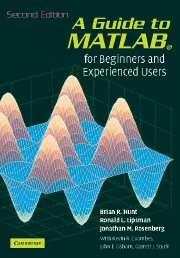Book contents
- Frontmatter
- Contents
- Preface
- 1 Getting Started
- 2 MATLAB Basics
- 3 Interacting with MATLAB
- Practice Set A: Algebra and Arithmetic
- Practice Set B: Calculus, Graphics, and Linear Algebra
- 6 MATLAB Programming
- 7 Publishing and M-Books
- 8 Simulink
- 9 ☆ GUIs
- 10 Applications
- Practice Set C: Developing Your MATLAB Skills
- Solutions to the Practice Sets
- Glossary
- Index
7 - Publishing and M-Books
Published online by Cambridge University Press: 05 September 2012
- Frontmatter
- Contents
- Preface
- 1 Getting Started
- 2 MATLAB Basics
- 3 Interacting with MATLAB
- Practice Set A: Algebra and Arithmetic
- Practice Set B: Calculus, Graphics, and Linear Algebra
- 6 MATLAB Programming
- 7 Publishing and M-Books
- 8 Simulink
- 9 ☆ GUIs
- 10 Applications
- Practice Set C: Developing Your MATLAB Skills
- Solutions to the Practice Sets
- Glossary
- Index
Summary
MATLAB is exceptionally strong in linear algebra, numerical methods, and graphical interpretation of data. It is easily programmed and relatively easy to learn to use. Hence, it has proven invaluable to engineers and scientists who rely on the scientific techniques and methods at which MATLAB excels. Very often the individuals and groups that so employ MATLAB are primarily interested in the numbers and graphs that emerge from MATLAB commands, processes and programs. Therefore, it is enough for them to work in a MATLAB Command Window, from which they can easily print or export their desired output.
However, other practitioners of mathematical software find themselves with two additional requirements. First, they need a mathematical software package embedded in an interactive environment, in which it is easy to make changes and regenerate results. Second, they need a higher-level presentation mode, which integrates computation and graphics with text, uses different formats for input and output, and communicates effortlessly with other software applications. These additional requirements can be accomplished using either cells and the publish command, or else the M-book interface, both of which were briefly described in Chapter 3. The present chapter goes into more detail and discusses some of the fine points of these methods.
Fine Points of Publishing
As we mentioned Chapter 3, the simplest way to produce a finished presentation with MATLAB is to prepare your work in a script M-file and then publish the result.
- Type
- Chapter
- Information
- A Guide to MATLABFor Beginners and Experienced Users, pp. 103 - 110Publisher: Cambridge University PressPrint publication year: 2006

